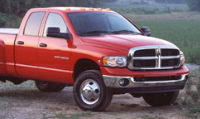electrical/lighting problem, completely lost
#21
Modifying the exterior lighting of the Ram truck starting with 2006 Model Year
The Ram truck has been designed and developed using standard incandescent lights. These lights
are controlled by a computerized module called the “Totally Integrated Power Module” (TIPM).
This module controls the left front, right front, left rear and right rear lighting independently. The
TIPM utilizes “smart” technology that has the ability to monitor the current (amp) on
some of the
lighting outputs. These monitored outputs include the headlamps, turn lamps, stop lamps and
reverse lamps. The module is able to detect both electrical short and open circuit conditions. The
module has a preset allowable current (amp) operating range for each of these outputs. If while
in normal operation the current detected falls outside this preset range, then a fault is set in the
module. In the case of too high of current the circuit will be shut off. This fault condition will
remain true until the current level falls back into the normal range. In the case of the turn lamp
circuits, if the module detects too low of current then the module will assume an open circuit
condition (burned out bulb) and the blinker will flash at a double flash rate.
This detection is in place to assist the customer in determining if there is an active short in the
lighting circuit or a burned out bulb (open circuit).
You can also get into these fault conditions by adding additional lamps to the circuits or by
changing the lamp specifications (i.e. changing the type of lamp used). This would include, but is
not limited to, the use of L.E.D.’s. By using them you run the risk of causing lighting faults or
loss of lighting functionality.
The question then becomes, “can you use L.E.D. lighting on the 2006 and beyond Ram trucks”?
The answer is yes, but special care and procedures need to be followed to use L.E.D.s
successfully
The Ram truck has been designed and developed using standard incandescent lights. These lights
are controlled by a computerized module called the “Totally Integrated Power Module” (TIPM).
This module controls the left front, right front, left rear and right rear lighting independently. The
TIPM utilizes “smart” technology that has the ability to monitor the current (amp) on
some of the
lighting outputs. These monitored outputs include the headlamps, turn lamps, stop lamps and
reverse lamps. The module is able to detect both electrical short and open circuit conditions. The
module has a preset allowable current (amp) operating range for each of these outputs. If while
in normal operation the current detected falls outside this preset range, then a fault is set in the
module. In the case of too high of current the circuit will be shut off. This fault condition will
remain true until the current level falls back into the normal range. In the case of the turn lamp
circuits, if the module detects too low of current then the module will assume an open circuit
condition (burned out bulb) and the blinker will flash at a double flash rate.
This detection is in place to assist the customer in determining if there is an active short in the
lighting circuit or a burned out bulb (open circuit).
You can also get into these fault conditions by adding additional lamps to the circuits or by
changing the lamp specifications (i.e. changing the type of lamp used). This would include, but is
not limited to, the use of L.E.D.’s. By using them you run the risk of causing lighting faults or
loss of lighting functionality.
The question then becomes, “can you use L.E.D. lighting on the 2006 and beyond Ram trucks”?
The answer is yes, but special care and procedures need to be followed to use L.E.D.s
successfully
#22
okay, issue solved. finally traced back allthe wires and there were multiple areas where wires were just corroded. I replaced those sections of wires and everything works. It looks like the corrosion was from previous electronic diagnostics using those multimeters that puncture the sheathing for the wire. It just started to wick up there and corrode from there. I guess that makes sense because there was a history of electrical problems on this truck. now i'm just worried about what other wires are degrading. atleast i have an idea of what to look for if things stop working.
Thanks for all the help! couldn't have figured this out without the forum!
Thanks for all the help! couldn't have figured this out without the forum!
#23
#24
okay, issue solved. finally traced back allthe wires and there were multiple areas where wires were just corroded. I replaced those sections of wires and everything works. It looks like the corrosion was from previous electronic diagnostics using those multimeters that puncture the sheathing for the wire. It just started to wick up there and corrode from there. I guess that makes sense because there was a history of electrical problems on this truck. now i'm just worried about what other wires are degrading. atleast i have an idea of what to look for if things stop working.
Thanks for all the help! couldn't have figured this out without the forum!
Thanks for all the help! couldn't have figured this out without the forum!



